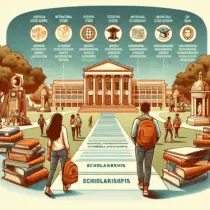Exploring Scholarship Opportunities for Online Degree Programs
In recent years, the landscape of higher education has transformed dramatically, with online degree programs rising in popularity. This shift has opened the door for many individuals to pursue their educational goals without the constraints of traditional on-campus attendance. As online education becomes more mainstream, numerous scholarship opportunities have emerged, making it more affordable for students to earn their degrees. This article explores the various scholarship options available for online degree programs and how students can take advantage of these funding opportunities.
The Growing Popularity of Online Education
Online degree programs offer flexibility and convenience, allowing students to study at their own pace and on their own schedule. This is particularly beneficial for working professionals, parents, and those with other commitments that make attending a traditional college challenging. As the quality and credibility of online programs have improved, more universities are offering a wide range of online degrees, from associate to doctoral levels.
Types of Scholarships for Online Programs
There are various scholarships available for students enrolled in online programs. These scholarships can be categorized into several types:
-
Merit-Based Scholarships
Merit-based scholarships are awarded to students based on their academic achievements, talents, or other specific criteria. These scholarships do not necessarily consider financial need but instead focus on a student’s accomplishments and potential. -
Need-Based Scholarships
Need-based scholarships are designed to assist students who demonstrate financial need. These scholarships evaluate a student’s financial situation, often considering factors such as family income, household size, and other economic indicators. -
Field-Specific Scholarships
Some scholarships are tailored to students pursuing specific fields of study. For example, scholarships may be available for students majoring in healthcare, technology, education, or business. -
Diversity Scholarships
Diversity scholarships aim to support students from underrepresented backgrounds. These scholarships encourage diversity and inclusion within various fields of study and institutions. -
Employer-Sponsored Scholarships
Many employers offer scholarships or tuition assistance programs for employees seeking to further their education. These scholarships may be available regardless of whether the degree is pursued online or on-campus. -
Institutional Scholarships
Many colleges and universities offer scholarships specifically for their online students. These institutional scholarships can vary significantly in terms of eligibility criteria and award amounts.
Finding Scholarships for Online Degree Programs
Identifying the right scholarships requires research and diligence. Here are some effective strategies for finding scholarship opportunities:
-
University Financial Aid Offices
The financial aid office at the institution where the student is enrolled or planning to enroll can be an excellent resource. These offices typically have information on available scholarships, including those specifically for online students. -
Scholarship Databases
Numerous online platforms and databases compile lists of scholarships. Websites like Fastweb, Scholarship.com, and College Board allow students to search for scholarships based on various criteria, including degree type and field of study. -
Professional Organizations
Many professional organizations offer scholarships to students pursuing degrees in their field. For instance, the American Nurses Association and the Institute of Electrical and Electronics Engineers offer scholarships to students in nursing and engineering, respectively. -
Community Foundations
Local community foundations often provide scholarships to students within their region. While some may be more aimed at traditional students, many are open to those pursuing online degrees. -
Employer Programs
Students should check with their employers about any available educational benefits. Some companies offer scholarships or tuition reimbursement programs for employees furthering their education, including online degree programs.
Applying for Scholarships
The scholarship application process can be competitive, so it is important for students to submit strong applications. Here are some tips to improve the chances of success:
-
Meet Deadlines
Missing deadlines is a common reason applications are rejected. It is crucial to keep track of all scholarship deadlines and submit applications on time. -
Tailor Applications
Each scholarship may have specific criteria and expectations. Personalizing each application to align with these requirements can make a significant difference. Generic applications are less likely to stand out. -
Write Compelling Essays
Scholarship essays are often a critical component of the application. Applicants should take time to write thoughtful, well-organized essays that highlight their strengths, achievements, and goals. Proofreading for grammar and clarity is also essential. -
Gather Strong Recommendations
Letters of recommendation from professors, employers, or other respected individuals can bolster a student’s application. It is important to choose recommenders who know the student well and can speak to their qualifications and character. -
Highlight Extracurricular Activities
Scholarship committees often look for well-rounded individuals. Highlighting involvement in extracurricular activities, volunteer work, or professional organizations can make a student more appealing.
Maximizing Scholarship Opportunities
Securing scholarships requires a proactive approach. Here are some strategies to ensure students maximize their scholarship opportunities:
-
Apply to Multiple Scholarships
Students should apply for as many scholarships as they qualify for. Applying for multiple scholarships increases the chances of receiving funding. -
Stay Organized
Keeping track of application deadlines, required materials, and submission statuses can prevent last-minute scrambles and missed opportunities. Creating a spreadsheet or using an application management tool can be helpful. -
Seek Smaller Scholarships
While large scholarships can be highly competitive, smaller scholarships may have fewer applicants. These smaller awards can add up and significantly reduce educational expenses. -
Renewable Scholarships
Some scholarships are renewable, meaning they provide funding for multiple years, provided the student meets certain criteria. Students should be aware of and apply for these ongoing funding opportunities.
The Impact of Scholarships on Online Education
Scholarships can have a transformative impact on a student’s educational journey. By reducing financial barriers, scholarships enable more students to access higher education and achieve their academic and career goals. This is especially significant for online degree programs, which often attract non-traditional students who may face greater financial constraints.
For many, scholarships make the difference between advancing their education and remaining stagnant in their careers. By easing the financial burden, scholarships allow students to focus more on their studies and less on financial concerns.
Challenges in Scholarship Funding for Online Students
Despite the availability of scholarships, online students may face certain challenges in securing funding. Some scholarships still have a preference for traditional, on-campus students. Additionally, misconceptions about the value and legitimacy of online degrees can sometimes affect the availability of scholarships.
It is also common for online students to juggle multiple responsibilities, such as work and family, making it more challenging to meet the criteria of certain scholarships that require extensive extracurricular involvement or academic commitment.
Conclusion
The rise of online degree programs has democratized education, making it accessible to a broader audience. Scholarships play a critical role in supporting this trend by providing financial assistance to those who need it. By understanding the types of scholarships available and utilizing effective strategies to find and apply for them, online students can significantly reduce the cost of their education.
Unquestionably, scholarships can serve as a powerful catalyst for personal and professional growth. They not only alleviate financial stress but also open doors to new opportunities and career advancements. As online education continues to evolve, the availability and variety of scholarships are likely to expand, further supporting students in their quest for knowledge and success.






